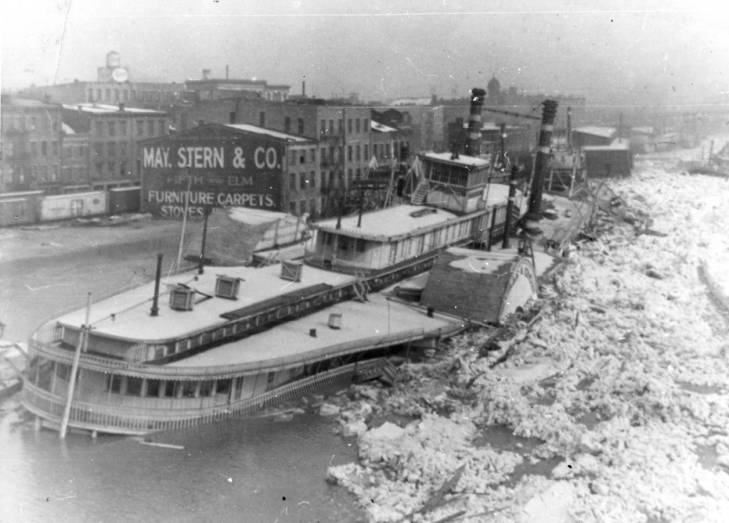Dealing with ice on the Ohio River

January is often one of the coldest months of the year; with the cold weather comes ice. While ice is much more manageable on the river today, in years past it posed a threat to steamboats and disrupted commerce. From ice flows to a frozen river, winter weather has a profound impact on life along the Ohio River.
Perils of ice
Before the construction of locks and dams along the Ohio River, river boats navigating downstream were at the mercy of weather changes. While fluctuating water levels in hot summer months created challenges for boats attempting to navigate the river, winter weather brought ice. Ice flows and ice gorges brought travel along the river to halt; some boats had to saw through the ice to free themselves and others were abandoned all together. Enough ice closed the river down and travel stopped anywhere from a few days to more than a month.
In 1855 cold weather and ice closed the river for a record-breaking 47 days. The latter half of the 19th century brought closures longer than 40 days three more times in the winters of 1874-75, ’92-’93 and ’94-’95. The early 20th century saw frozen temperatures in 1904, but the winter of 1917-18 showed the destructive power of ice.
.png)
Winter of 1917-18
Earlier winters demonstrated the stopping power of a frozen river, December of 1917 and January 1918 delivered the damaging side of nature. As temperatures dropped, ice flows formed on the river and wrought havoc on boats along the banks. Sharp ice pierced hulls or piled on deck, weighing down and sinking boats. In fact, 36 boats sank on the Ohio River that winter taking $1 million in damages to the bottom with them. Today that would be more than $16 million in ice damage.

Ice on the river
Even with the addition of locks and dams on the Ohio in the 1920s, freezing continued to have an impact on the river. A cold snap in 1940 closed the waterway for 16 days. More recently – a little more than 40 years ago – the winters of 1977 and ’78 saw periods of below-freezing temperatures for twenty consecutive days. Frigid temperatures combined with a slow-moving river led to eight to 12 inches of ice from bank to bank. (Some brave individuals crossed the river on foot and others tried driving.) The winters of 1977 and ’78 are the only times the Ohio River has frozen solid since the Army Corps of Engineers decommissioned Chilo Lock 34 and opened Meldahl Dam in 1964.
While the Ohio River hasn’t completely frozen in 40-plus years, ice still forms. In fact, 2018 opened with a string of sub-freezing days that iced the river from its banks to several yards out. However, with increased river traffic and river depth, the chances of a complete freeze are low, but it could happen again. When? Only time will tell.
To learn more about the history of life along the Ohio River, visit Chilo Lock 34 Visitor Center and Museum from 11 a.m. to 4 p.m. Tuesday through Sunday.

